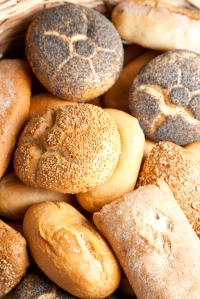This requires thought…. too often we just grab something quick and easy without awareness and eat it too quickly and too much.
 What do you habitually choose?
What do you habitually choose?
Breads and carbohydrate rich foods are easy to get access to and have their place if you are involved in an activity or occupation that requires strenuous muscular effort.
Fresh vegetables and fruits are abundant in Australia and even though the price of bananas has been high due to tropical cyclone & flood damage, a few bananas are a better alternative to processed convenience food laden with artificial chemical additives, trans fats and sugars. It is more than worth the effort to read the labels and choose foods that have fewer ingredients listed on them, for your long-term health.
There are some simple rules to observe when eating for energy:
- Eat when you are hungry. Sounds obvious, but we often eat when we are not, for a variety of reasons. These could be emotional eating, regulated meal times or that we have eaten too much at the last meal.
- Avoid eating at times when you are tired, run down, stressed or ill. Stress causes
 the body to divert its attention away from the digestive process, so take a glass of water, a few minutes to meditate or calm down and wait until you are feeling hungry.
the body to divert its attention away from the digestive process, so take a glass of water, a few minutes to meditate or calm down and wait until you are feeling hungry. - Eat slowly and with mindfulness so that you can truly be aware of the flavour and texture of your food and become aware of the life force within it. (assuming you are not eating processed food!)
- Plan your meals to occur at regular times. Include snack times, so that you have something to eat about every 3 hours.
- Eat breakfast – this should be your biggest meal and dinner the lightest, which is completely opposite to what most of us do. Ensure that your last food intake is at least 3 hours before going to bed, so that digestion can begin effectively.
There are several schools of thought about what you should be eating.
You might want to consider the following:
- food miles – how far has your food travelled to get to you?
- food combining – this means not combining carbohydrates with protein or acid fruits. Proteins can be divided into 3 more groups – animal flesh, dairy and nuts/seeds.
- Mono meals – choosing one particular food for a meal and eating nothing else.
- Vegetarian – choosing to forgo eating animal flesh for either ethical reasons or religious reasons.
Eating for energy is not a diet plan, it is a method of making better choices about what food to fuel your body and for the planet. Learn which foods are acid forming and which are alkaline. Alkaline foods are vegetables, salads, fruit (except plums & cranberries), almonds and milk. Acid foods are all animal proteins, cheese, nuts and foods made from cereals. Check for sugar content. Refined sweets & sugars are metabolized quickly by your body and will result in that “sugar crash” and further stress your body, leading to long-term to insulin resistance in susceptible individuals.
There are any number of websites and books that can further educate you on which foods are best for you. Ultimately it is up to you to experiment with what types of foods give you the most health and energy. Sue Dengate’s book Fed Up is useful to discover what additives are in your food. The food combining plan devised by Dr William Hay has helped many people regain health. The Polarity Diet by Dr Randolph Stone is a wonderful way to regain energy and health.